RECOIL OFFGRID Survival Can Conventional RVs Work In A Bug-Out Scenario?
What makes a truly great survival vehicle? If someone asked you this question, you might reply with qualities like a powerful engine, high ground clearance, a huge payload of supplies, bright auxiliary lights, winches, push bars, and possibly even armor plating. Although we can certainly agree that all these features could come in handy, they also have a tendency to make the vehicle in question conspicuous — and in a survival scenario, that’s the last thing you want to be. If your ride’s appearance screams, “I’m prepared for anything,” sooner or later someone less prepared will try to take it from you.
That said, consider a mobile survival platform that’s common enough to blend in, spacious enough to be comfortable, and tough enough to use for years without repairs. Fortunately, there’s a type of vehicle that’s readily available and meets all these criteria — the recreational vehicle, or RV.
An RV will never be as stealthy as a motorcycle, or as capable off-road as a Jeep, but these homes-on-wheels are easy to find just about anywhere. Their living quarters provide plenty of room for gear and supplies, and best of all, anyone behind the wheel will end up looking more like a retiree on vacation than a hardened survival expert. So, don’t discount that old motorhome in grandma’s driveway just yet — it can be a real asset if you need to bug out.

A recreational vehicle is simply a motor vehicle with an attached living space. A wide range of vehicles can be considered RVs, from massive tour-bus-sized motor coaches to tiny pop-up trailers. There are three main categories of RV: motorhomes, trailers, and campers. Each class of RV has its own pros and cons to consider, so read on to determine which best fits your needs.
The first and most common type of RV is the motorhome. These vehicles are characterized by the powertrain and living quarters integrated together into a single package. Many motorhomes simply replace the rear section of a truck or van’s body with living quarters, retaining the original chassis, engine, and driving position. These vehicles are known as Class C or midsize motorhomes, and can be identified by an extended section over the cab that often contains a bed.
The second category of motorhomes is the smallest, known as Class B (also called camper vans or conversion vans). These vehicles don’t feature an extended section over the cab, resulting in a lower-profile roof. Often, Class-B motorhomes are based on passenger vans, like the Mercedes-Benz Sprinter, Ford E-Series, or Chevrolet Express. The biggest upside to this design is its appearance — some Class-B motorhomes aren’t easily recognizable as RVs, and therefore avoid unwanted attention in a survival scenario.
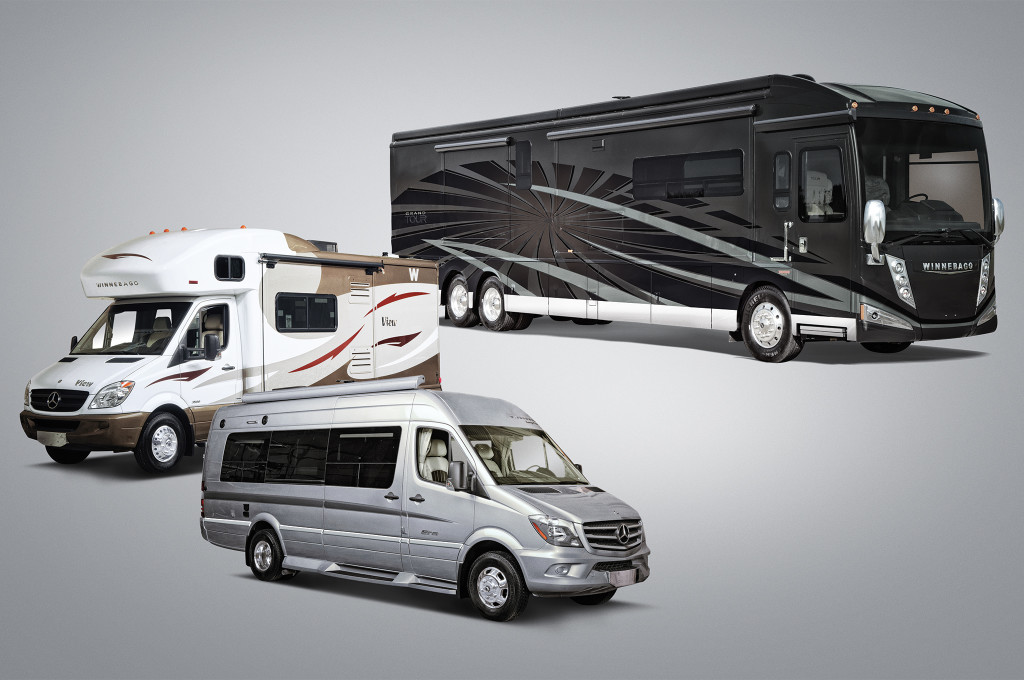
From left: The Winnebago View: Note the extended sleeping area directly above the vehicle’s cab, this identifies...
Finally, Class-A “integrated” motorhomes are built from the ground up, with driving position inside the living area. These mega-motorhomes are typically larger, feature a vertical windshield, and appear more similar to a commercial bus than to a passenger car. Features can include washer/dryer sets, expandable rooms, and even underside storage compartments for motorcycles or ATVs. As cool as that sounds, due to their cumbersome nature and noticeable appearance, Class-A motorhomes are better suited to transporting rock stars and celebrities than surviving the apocalypse. If you’re behind the wheel of one of these giants, most onlookers will assume it has lots of desirable resources inside, and that’s not a good thing in a dangerous situation.
From a cost standpoint, motorhomes run the gamut from tens of thousands to several million dollars. In a survival scenario, keeping a low profile is more important than having a fancy built-in jacuzzi or movie theater, so it’s probably wise to avoid the more luxurious and expensive models. In addition, large Class-A motorhomes will be more difficult to maneuver and much more conspicuous on the road, so we recommend sticking to the smaller Class B and C motorhomes when SHTF.
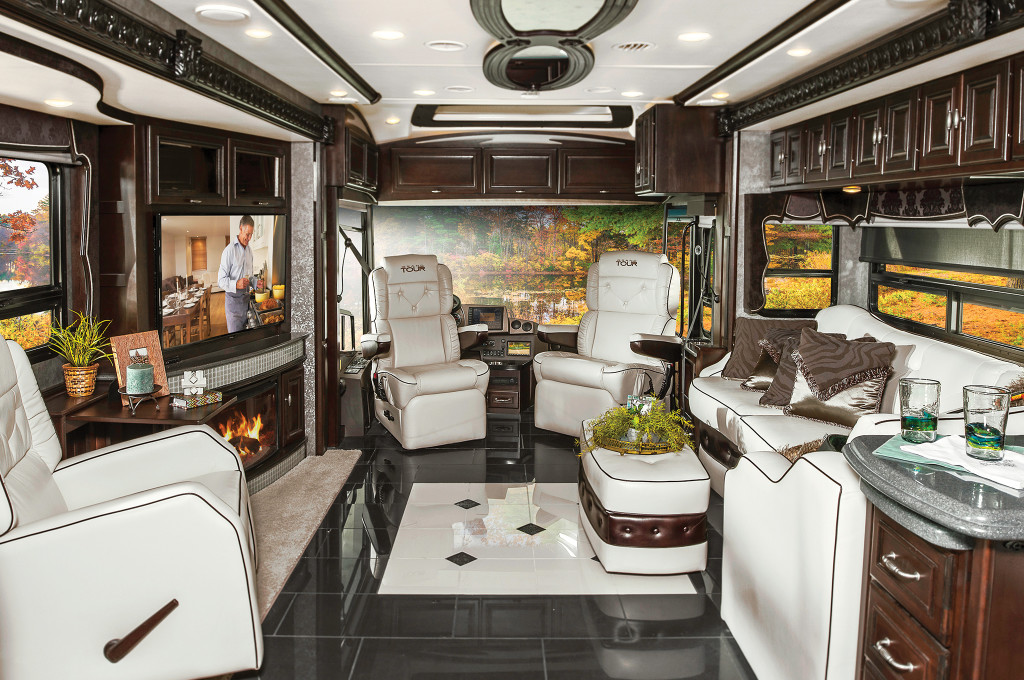
Here’s the interior of the Winnebango Grand Tour. This palace on wheels will make you forget you ever evacuated...
Pros:
Cons:
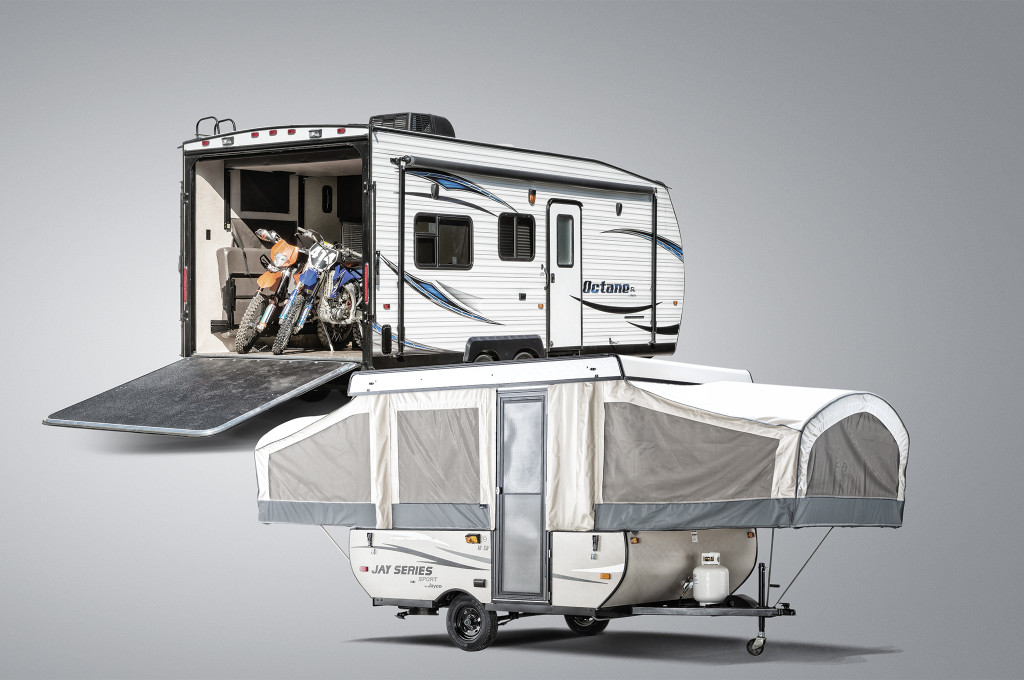
The second type of RV is the travel trailer or caravan. Just as the name implies, travel trailers are living quarters that attach to a car or truck via a tow hitch, and can only move when towed. These are the oldest form of RV, dating back to the 1920s, and are relatively mechanically simple due to their dependence on a tow vehicle.
Travel trailers can be much smaller than a compact car, nearly as big as a city bus, or anywhere in between. Smaller trailers can be towed by an ordinary car, while the larger 30- to 40-foot trailers may require a purpose-built tow rig. For the purposes of survival, small and mid-size trailers shorter than 25 feet in length are ideal, as they can be towed by common pickups and SUVs.
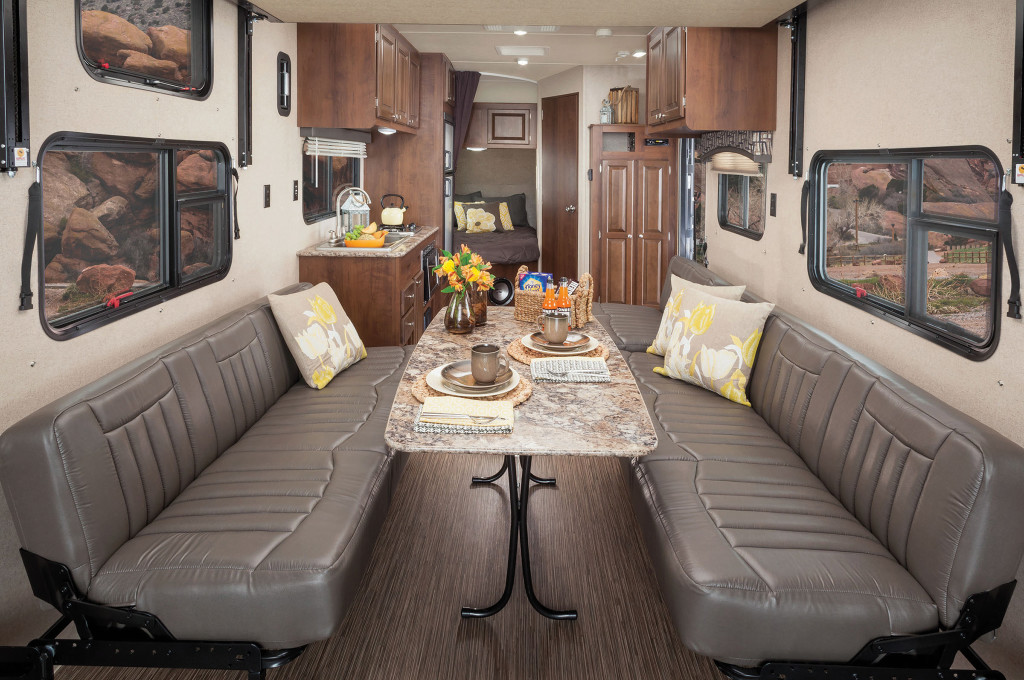
Trailers are highly versatile and provide many options, such as the vehicle storage space of this Jayco Octane toy...
Within the trailer category, there are several sub-groups to be aware of. Pop-ups, or expandable trailers, are handy for survival due to their low profile on the road and abundance of space when parked. Teardrops are small, aerodynamic, and lightweight (some can even be towed by a motorcycle). Toy haulers feature a fold-down rear ramp and storage space for ATVs or motorcycles. Finally, fifth-wheel trailers attach to an in-bed hitch (much like that of a semi truck) instead of a bumper hitch, resulting in improved on-road stability. However, fifth-wheel trailers are often larger and require specialized tow vehicles, so they may be less than ideal for survival.
The biggest advantage of a trailer is its ability to be disconnected from the tow vehicle. This enables establishing a home base far away from prying eyes, leaving the area in your vehicle to go on supply runs, and returning to your living quarters unnoticed. It’s wise not to put all your eggs in one basket, and travel trailers make this easier than it would be in any other type of RV.
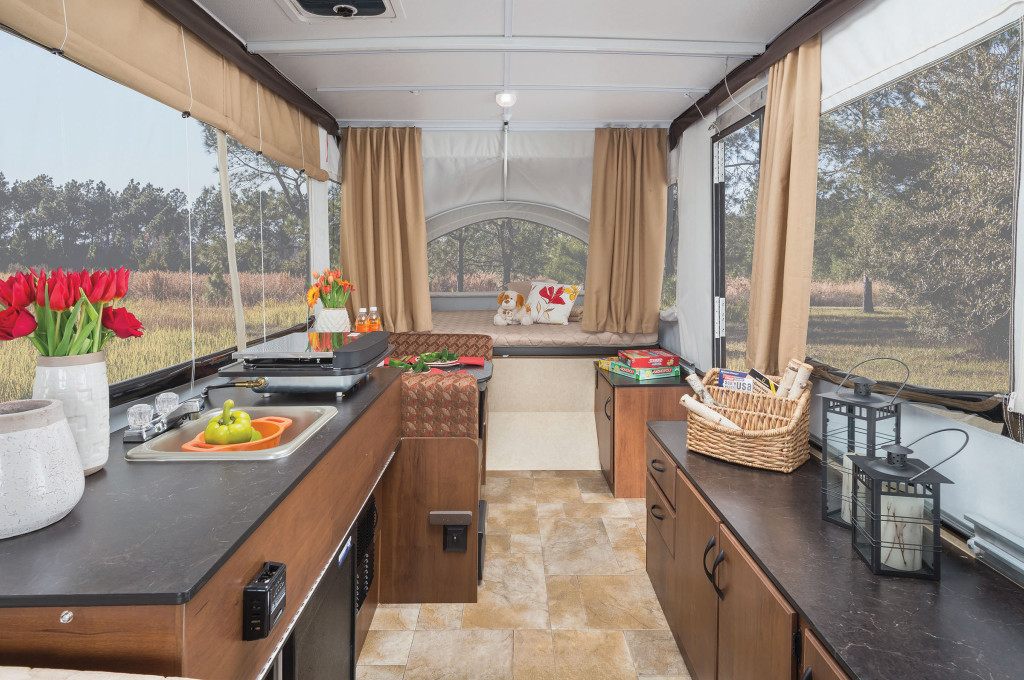
The Jayco Jay Series Sport, a compact pop-up trailer that also features pop-out expandable sleeping areas.
Pros:
Cons:
The third type of RV is the camper. Also called slide-in, dismountable, or truck campers, these RVs are removable living quarters that sit inside the bed of an ordinary pickup truck. Campers benefit from the compact size of trailers, but feature even better mobility since they don’t require towing experience — if you can drive a regular pickup truck, you can drive a truck with a camper. Like trailers, truck campers can also be removed from your vehicle temporarily, although it will take longer than simply unhitching a trailer. In order to dismount a truck camper, it must be jacked up using four corner jacks, then any turnbuckles or tie-downs must be disconnected before the truck can drive out from under the camper.
The type of camper you can use is typically determined by the type of truck you have access to. If you have a 1/2-ton short-bed truck with a gas engine, your options will be limited to smaller campers, but if you have a 3/4- or 1-ton truck with a longbed and diesel engine, there will be many more choices available. Modern truck campers have most of the amenities of a comparable motorhome or trailer, including refrigerators, ovens, bathrooms, and showers. Some campers feature pop-up or expandable sections that provide extra space when parked and a lower profile on the road.
In a survival situation, an ordinary 4×4 diesel truck with a compact pop-up camper would be an excellent choice. This setup won’t draw as much attention on the roads as other RVs, is highly capable off-road, and will provide more than enough space for two adults and their supplies. It won’t be as spacious as a motorhome, or as modular as a trailer, but it’s certainly a nice happy medium.
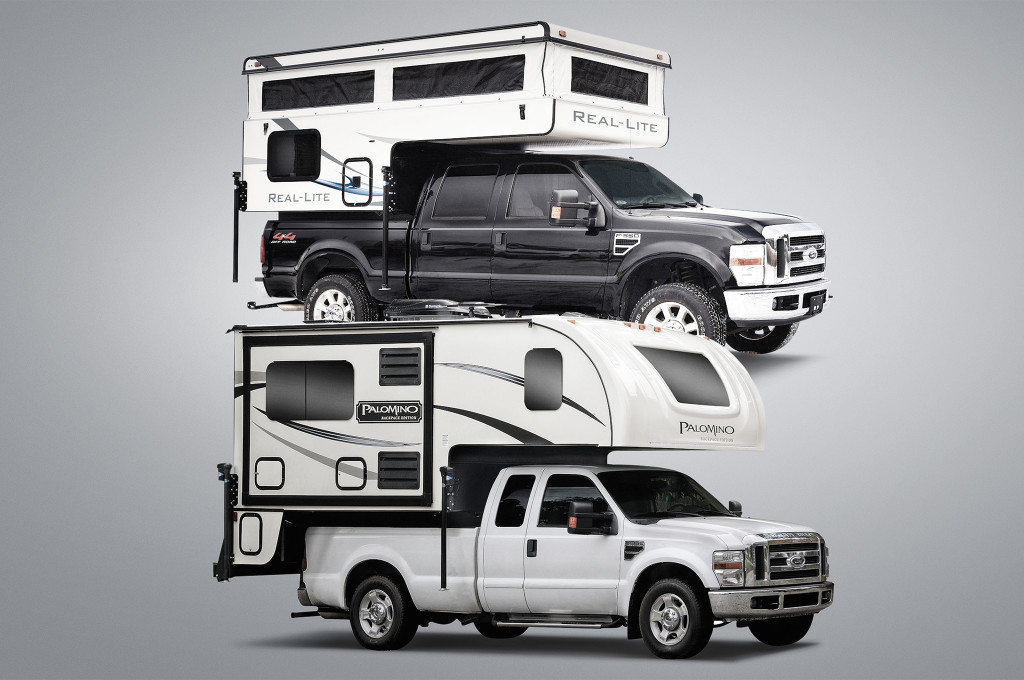
From top: A pop-up truck camper, the Palomino Real-Lite. The expandable top section provides enough height to stand,...
Pros:
Cons:
Given these three categories of RVs, you must choose what’s best for your location and conditions. For example, a large Class-A motorhome might be fine in the flat, sparsely populated Nevada desert. However, it would be a terrible choice for the densely packed streets of New York or Chicago, where a compact car with a teardrop trailer might fare better. If you need to survive in the tough terrain of the Sierra Nevada mountains, an expedition vehicle or 4×4 truck with a slide-in camper would probably serve you best.
You must also take into consideration the number of occupants and quantity of supplies you’ll be transporting. A small trailer or camper might serve one person well, but if you have a large family, look into motorhomes or large trailers. Regarding supplies, extra gear can be strapped to your vehicle’s roof, stored in the vehicle’s cabin, or packed creatively in the living area itself. Much like building a bug-out bag or in-home emergency supply cache, you need to decide a time frame to plan for, and pack supplies accordingly.
Consider this guide a primer on choosing an RV for survival — there’s still plenty to learn before you actually bring one home. Some might say the common RV is too obvious a choice for a bug-out vehicle, but we’d say it’s an obvious choice for a reason. Someday, one of these versatile vehicles might make your life on the road a whole lot easier.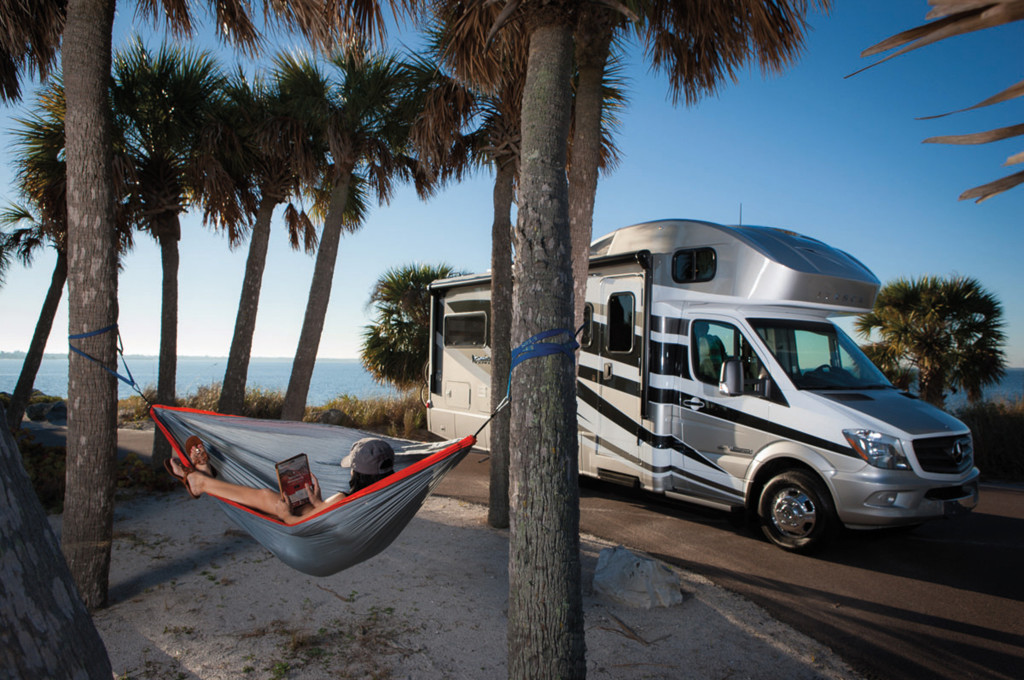
Taking the Path Less Traveled
Aside from the three classes of motorhomes listed in the main story, there’s an important sub-group to be aware of: expedition vehicles, or off-road motorhomes. These vehicles are designed specifically with extreme conditions in mind, and often have heavy-duty suspensions, large tires, four-wheel drive, and other off-road-oriented upgrades. If you need to go just about anywhere, be totally self-reliant, and truly prepare for the worst, you’ll want one of these monsters.
Expedition vehicles can fall into any of the above classes, and range from simple living quarters placed on the back of a lifted pickup truck to purpose-built behemoths with six- or eight-wheel drive. However, given this article’s premise of staying inconspicuous, expedition vehicles may not necessarily be a wise choice. First of all, they tend to be much more expensive than a traditional motorhome and typically must be special-ordered from the manufacturer, so they’re not easy to obtain. Secondly, they’re definitely going to draw more attention than an ordinary motorhome as you roar down the road on huge mud tires.
So, in a bug-out scenario where you’re heading into isolated wilderness for an extended period, an expedition vehicle would be ideal. However, in a situation where you may need to frequently use public roads or leave your vehicle exposed to gather supplies, these vehicles may cause more problems than they solve.
 STAY SAFE: Download a Free copy of the OFFGRID Outbreak Issue
STAY SAFE: Download a Free copy of the OFFGRID Outbreak Issue
No Comments